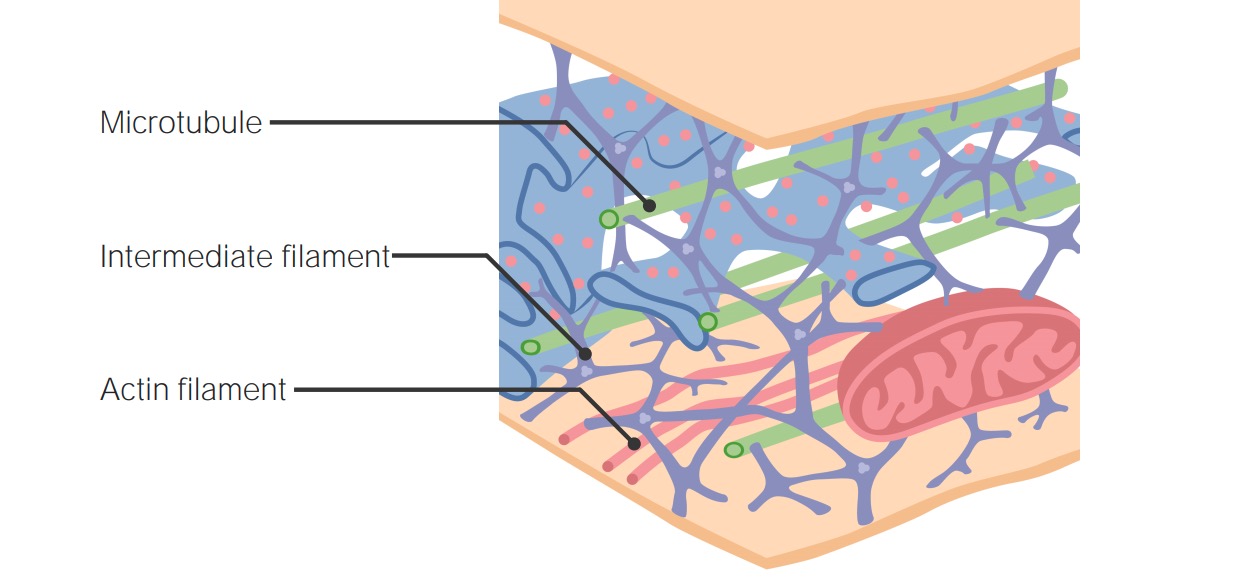Playlist
Show Playlist
Hide Playlist
Transport and Network of Proteins
-
Slides 07 Membranes CellBiology.pdf
-
Reference List Molecular and Cell Biology.pdf
-
Download Lecture Overview
00:00 We said the microtubules form highways through the cells. 00:03 So, how would I get something made in the cell body of this neuron all the way to the other end of the neuron? Along these highways, but you can't just crawl along the highway. 00:13 It turns out that we're learning that there are some really fantastic machinery going on inside the cells too. There are actual molecular motors. 00:22 Now, if you had to make a molecular motor that was going to move along one of these microtubule highways, what sort of things do you think you would need? You'd first need probably something to carry the stuff and a place for it to sit, and a way to attach it, and then some means of propulsion, right? And so, that's exactly what the cell has done to overcome this need to transport things down the microtubules. 00:51 So, here we go. We could have an actual organelle that's being moved. 00:55 Maybe we're moving a mitochondria to the other end of the cell because we need to get some energy going down there, or maybe we're moving a load of neurotransmitter that's just been made up in the cell body and we need to move that down to the end of this neuron. 01:10 So, we stick it on this little vehicle, which is our cellular motor, and we give it a platform and a means of propulsion. 01:22 So, dyneins are these proteins that allow movement or motor proteins that allow movement, pushing the vehicle along that microtubule. 01:32 Now, we need the motor to be stabilized down there with the help of dynactin. 01:35 That allows us to have this assembly that moves down the microtubule. 01:42 We have anterograde moving away and retrograde coming back. 01:47 Transport. So, we can take stuff out in a cell and we can bring stuff back. 01:52 Those molecular motors are slightly different from one another, but they essentially work in the same fashion. 02:00 So, the interior network of cytoskeletal elements or proteins that are cytoskeletal elements are actually connected pretty well to an exterior network of proteins that we call the extracellular matrix. 02:14 The place that they're most tightly connected is at these proteins called integrins. 02:20 Those are the proteins that anchor many of the cytoskeletal elements to the edge of the cell in order to form more structure for that cell. 02:28 These proteins transfer across the membranes. 02:32 They're transmembrane proteins that also have domains on the outside of the cell. 02:38 And they are associated with other fibers like collagen and elastin and glycoproteins and some other peptidoglycans so that the cell has some sort of protection, because you'll recall, animal cells don't have a cell wall like bacteria do or plant cells do, or fungal cells do. 02:59 And so, this extra cellular matrix's function is to provide some degree of protection to the cell, as well as allow the cells to identify themselves.
About the Lecture
The lecture Transport and Network of Proteins by Georgina Cornwall, PhD is from the course Cellular Structure.
Included Quiz Questions
Which of the following is NOT true regarding the cytoskeletal system in a cell?
- Dynactin is related to the synthesis of proteins in the extracellular matrix.
- Cytoskeletal motors in a cell are associated with the transport and positioning of membrane-bound organelles.
- Kinesin and dynein are motor proteins that move along microtubule tracks by using ATP as an energy source for the rapid transportation of materials.
- Rapid transport of mitochondria in energy-deficient areas of a cell, movement of secretory vesicles, and axonal transport are good examples of the cytoskeleton-mediated transport system.
- Anterograde transport is facilitated by kinesins and retrograde transport is facilitated by dyneins.
The extracellular matrix in animal cells helps in which of the following?
- Cell identification and protection
- Cell division
- Transportation of ATP molecules inside the cell
- Synthesis of ATP molecules by using sunlight
- Assembly of fully functional ribosomes for the translation process
Customer reviews
5,0 of 5 stars
| 5 Stars |
|
5 |
| 4 Stars |
|
0 |
| 3 Stars |
|
0 |
| 2 Stars |
|
0 |
| 1 Star |
|
0 |




